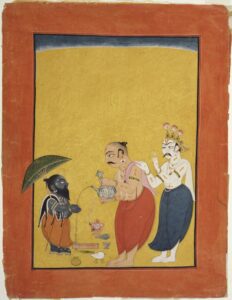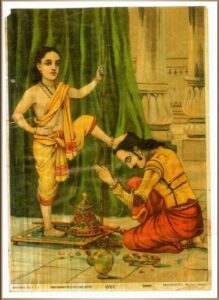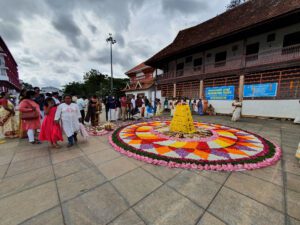Onam, its legacy, and its traditions serve as a remembrance of an ideal time, and its continued celebration act as a reminder to revive it.

Kerala's golden era was under the reign of King Mahabali or Maveli, an Asura king. (iStock)
It’s that time of the year again when the streets of Kerala are lined with flower vendors, and each household has begun its hunt for the best palada payasam they can get their hands on.
By the afternoon of Tuesday, 29 August, it is likely that the state has lulled into a collective post-sadhya nap. With bellies as full as hearts, everyone will be blissfully ignoring the impending return to regular life after celebrating one of Kerala’s most beloved festivals: Onam.
Marked as one of the most important dates on the Malayalam calendar, Onam has roots that run deep into Indian history and mythology, while also extending its reach to include more cultures and communities in its celebration.
As the world moves forward in time and Onam’s popularity grows beyond Kerala’s borders, tracing the journey of the festival reveals the story of its past and why our yearly celebration of it is most relevant today.
As legend has it, Kerala’s golden era was under the reign of King Mahabali or Maveli, an Asura king in Hinduism who is considered one of the Chiranjivi, a group of immortals.

Mahabali serves Vamana, while a suspicious Shukra tries to stop him. Painting from Mankot, Jammu and Kashmir, c. 1700-25. (Wikipedia)
Mahabali was so loved by his people that his popularity and power made the Devas (gods) jealous.
The preference of an asura over a deva presented a threat to their cosmic order, as the asuras were a class of divine beings who, in Indian mythology, as we study it today, are associated with evil.
With this judgement, the devas conspired to end Mahabali’s reign.
As the story goes, Vishnu appeared in the form of a dwarf Brahmin named Vamana, who requested King Mahabali for three feet of land.
When the generous king obliged, Vamana returned to his original gigantic godlike form. To demonstrate his power, he covered the entirety of the universe in two feet and asked Maveli for his third foot of land.
The king accepted his fate and offered his own head to be stepped upon, submitting defeat to the Gods.
Mahabali was exiled to Patala (the underworld), but in return for his generosity, he was given leave to visit his land and his people once every year, on the day of Onam.
While Onam is a harvest festival celebration, the mythical backdrop upon which it is observed reveals a story of power relations that govern a “natural order”, where the privilege of one’s identity and position is prioritised over collective peace and prosperity.
“The legend of Mahabali can be interpreted as a story of Aryanisation in Kerala,” Dr KS Gracy, former HoD of History at St Peter’s College, Kollanchery, told South First.
“The Devas and Asuras symbolically represent the Aryan and Dravida communities. Mahabali’s legend emphasises the clear vision of the Aryan community, who wanted to gain dominance over the Dravidians,” she said, introducing a popular angle that academics use to measure the political history behind Onam.

Vamana avatar of Lord Vishnu stomps on Bali’s head and sends him to Patala.
(Raja Ravi Varma, Public domain, via Wikimedia Commons)
Celebrated as the homecoming of Mahabali, Onam is a homage paid to the benevolent king’s rule when the land and its people experienced peace, justice, and harmony — a social atmosphere that may have dissipated upon Mahabali’s exile.
In the shadow of a natural order that demanded people to fear the Devas more than extend their love for an Asura king, Onam’s myth tells the tale of a group that desired power to the extent of destroying forces that upheld a land’s unity and prosperity, possibly leaving it divided, confused, and starting from scratch — a history that our country is all too familiar with.
With this perspective, Mahabali takes the shape of a mythological martyr whose Kerala was a land free from social evils.
The popular Onam song Maveli Naadu Vaneedum Kaalam (When Maveli Ruled Our Land) chronicles the king’s reign, painting a picture of the socio-cultural ethos of the time.
“The first two verses are always given emphasis,” shares Abhijith Pookulangara, a research fellow at MG University, referring to the lines Maveli naadu vaneedum kaalam / manushyar ellarum onnupole” (When Maveli ruled our land, all people were one).
“This bit refers to the present, where such inequalities are obviously an issue, but there is a huge history behind the song,” he reveals, emphasising the caste politics behind Onam songs and the reason why they celebrate a mythological era of equality and justice.

Onam is an ancient festival of harvest. (iStock)
“It’s logical that if you’re celebrating a harvest song, you need to know who harvested what. It wasn’t the people in the upper echelons of society,” Abhijith shares, revealing the possible revolutionary roots that exist in the Onam song’s history.
“The royalty of Kerala was not interested in Mahabali. The figure of Mahabali emerged into the academic limelight only because Dalit historiography was being researched,” he shares, crediting the works of other scholars like Dr Ajay Shekhar, assistant professor of English at the Sree Sankaracharya University of Sanskrit in Kalady.
“If you read the version of the song written by Sahodaran Ayyappan, you get an idea of the prevalent social issues in Kerala,” he revealed.
While authorship is a subject of debate, many refer to social reformer and thinker Sahodaran Ayyappan’s version when focusing on the unifying spirit of the Onam song.

A statue of Sahodaran Ayyappan. (By Challiyan at ml.wikipedia)
Ayyappan’s version, written in the 1920s, was simply titled Onapaattu (Onam song) and explicitly recited verses that criticise Brahmanical supremacy and reminisce about the mythological age of Mahabali, when people were free from caste oppression.
Supplementing the Dalit study on the legend of Mahabali, Dr Ajay Shekhar told South First, “The myth of Vamana pushing Mahabali into the netherworld represents the annihilation of Buddhism by Brahmanical Vaishnavism in Kerala”.
“Sahodaran Ayyappan’s Onapattu explains it. He also appeals to end the ideology of Vamana and bring back the just rule of Maveli. Such works by Sahodaran and Mooloor must be taught in schools”, he added.
Lines such as theendalumilla, thodeelumilla (There is no untouchability) and saadhu dhanika vibhaagamilla (There is no rich, no poor) praise a time of freedom and equality, after which the song reveals the establishment of an oppressive system.
Verses such as Brahmanarkeershya valarnnu vannee / bhoodhi keduthaan avar thuninju (The Brahmins became restless / And so, tried to destroy this prosperity) and kollunna kroora madham ethi (a violent religion emerged) refer to the end of prosperous times at the hands of injustice and discrimination.
“Being a harvest festival, it’s only logical that when the lower castes worked in the fields, they created the songs, incorporating the evils they endured,” Abhijith said.
“Why can’t we read this song as a ‘song of resistance’?” he asks, citing its similarity to plantation worker songs that were popular among slaves in America.
As these tunes take over Kerala today, the continuing and ever-growing love for Onam shines bright as a beacon of hope, suggesting that there just might be a possibility of reliving that lost age of peace and unity.
Walking around any city in Kerala during the 10-day festival, you see people from different cultural and religious backgrounds, adorned in traditional mundus and Kerala sarees, returning from their own Onam celebrations.

Today, Onam is celebrated across the state and the world. (iStock)
This year’s theme, Onam, Oru Eenam (Onam, a song/tune), echoes the unifying spirit of the festival, which is now celebrated across the state and the world.
Taking the tradition with them, Malayalis who have settled outside the country religiously celebrate Onam, inviting different communities to partake in the festivities.
As Onam’s popularity continues to grow and bring people from different backgrounds together, one can wonder whether the chiranjivi Mahabali’s reign has, in fact, been immortalised.

Apr 28, 2024

Apr 25, 2024

Apr 25, 2024

Apr 24, 2024

Apr 24, 2024

Apr 24, 2024